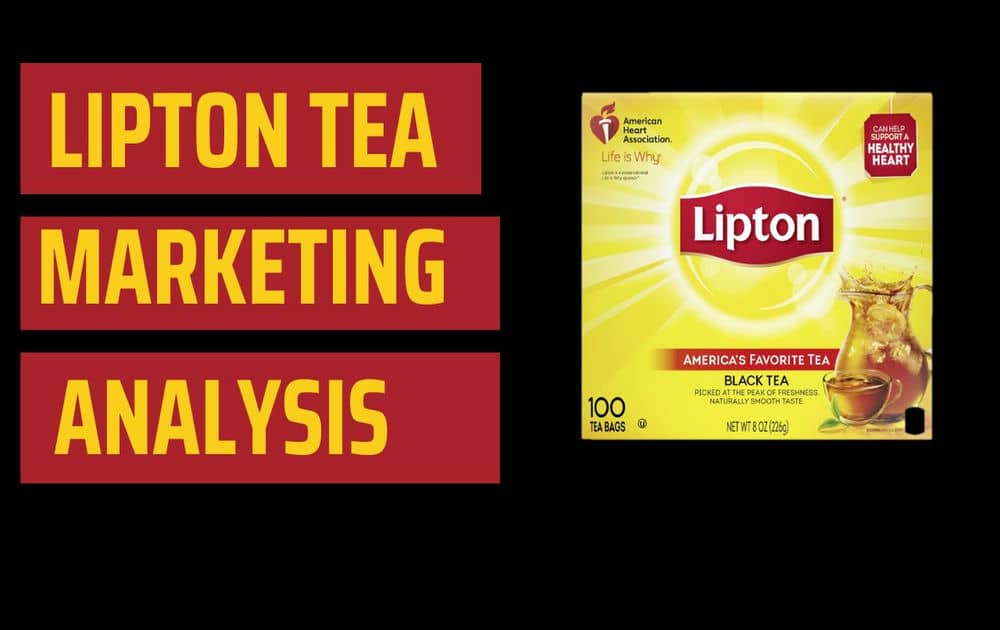In this article, you will learn about Lipton Tea Marketing Analysis. It will include Introduction, Vision Statement, Mission Statement, SWOT Analysis, Segmentation, Target Market, Success Strategies, Marketing Mix (4P’s) Strategies of Lipton
Introduction
Lipton is a British brand of tea, owned by Ekaterra. In the United Kingdom, Lipton was a supermarket chain. After being acquired by Argyll Foods, the company stopped to sell anything other than tea.
The company is named after its founder, Sir Cole Herman, who went by Mr. Lipton, who founded it in 1890. They also prepare soup, though it is less popular.
Lipton’s main pillar brands are Lipton Yellow Label and Lipton Iced Tea. The Lipton pyramid line in Europe and North America and Lipton Milk Tea in East Asia are other categories of products. The company introduced Lipton Linea to Western Europe in 2008.
Lipton: Vision Statement
The vision statement of Lipton Tea is that every person should easily purchase the tea. It should be in an arm’s reach for everyone.
Lipton is currently the best-selling tea in the world thanks to its commitment to quality. Lipton provides a means for tea lovers to enjoy their favorite tea in a pleasant and energetic way.
Lipton: Mission Statement
The Lipton’s Tea mission is to provide for everyone’s daily requirements while anticipating the aspirations of customers in order to respond competitively and creatively with products that improve quality of life.
Additionally, Lipton aims to attract and develop highly talented individuals that are enthusiastic, motivated, and driven to producing growth to the product.
SWOT Analysis of Lipton
STRENGTH:
- Excellent flavour and taste
- Having global presence
- Strong aroma
- Excellent packing
- Reputed brand image
- Good Distribution channels
- Easy Resource availability
- Good brand awareness and advertising
WEAKNESS:
- It is having Weak social media presence
- Price is higher as compare to competitor
- It is having Substitutes. Can be easily substituted with tea or coffee.
- In high tea drinking countries (India, China, Japan), it is having low shares.
- Can be effected by a storage issue or moisture
- The investment on research and development is very low amount as contrast to the competitors
OPPORTUNITIES:
- For rural areas, less expensive packs
- Emphasis on Tea loving Countries
- Corporate partnerships and hotel collaborations
- Lipton should explore the coffee market
- Improve Research and Development
- Because interest rates are cheap, there is a chance to invest in big projects.
- Globally, the number of social media users is rising
THREATS:
- There is a high competition in urban as well as rural areas
- Tea prices are increasing internationally
- Exports might be affected by political conditions
- The brand may be badly impacted by the country’s high inflation rate.
- The number of substitute products are rising as well.
- There isn’t a consistent supply of innovative goods
- Lack of trained labour in some international marketplaces threatens Lipton’s ability to maintain continuous profit growth in such countries.
- New competitors entering the market represent a threat.
| STRENGHTS: ✔ Excellent flavour and taste ✔ Having global presence ✔ Strong aroma ✔ Excellent packing ✔ Reputed brand image ✔ Good Distribution channels ✔ Easy Resource availability ✔ Good brand awareness and advertising | WEAKNESS: ❌ It is having Weak social media presence ❌ Price is higher as compare to competitor ❌ It is having Substitutes. Can be easily substituted with tea or coffee. ❌ In high tea drinking countries (India, China, Japan), it is having low shares. ❌ Can be effected by a storage issue or moisture ❌ The investment on research and development is very low amount as contrast to the competitors |
| OPPORTUNITIES: ✔ For rural areas, less expensive packs ✔ Emphasis on Tea loving Countries ✔ Corporate partnerships and hotel collaborations ✔ Lipton should explore the coffee market ✔ Improve Research and Development ✔ Because interest rates are cheap, there is a chance to invest in big projects. ✔ Globally, the number of social media users is rising | THREATS: ❌ There is a high competition in urban as well as rural areas ❌ Tea prices are increasing internationally ❌ Exports might be affected by political conditions ❌ The brand may be badly impacted by the country’s high inflation rate. ❌ The number of substitute products are rising as well. ❌ There isn’t a consistent supply of innovative goods ❌ Lack of trained labour in some international marketplaces threatens Lipton’s ability to maintain continuous profit growth in such countries. ❌ New competitors entering the market represent a threat. |

Segmentation of lipton
GEOGRAPHIC SEGMENTATION
Lipton’s geographic target markets are India, United States and Europe, but after establishing their brand in these countries, they will expand it in other countries as well.
DEMOGRAPHIC SEGMENTATION
It includes every age category lower, middle as well as upper income classes
PSYCHOGRAPHIC SEGMENTATION
Higher-Middle class, Middle class, Lower-Middle class
GEOGRAPHIC SEGMENTATION

- USA
- Europe
- India
DEMOGRAPHIC SEGMENTATION

- Lower Income class
- Middle Income class
- Upper Income class
PSYCHOGRAPHIC SEGMENTATION

- Higher-Middle class
- Middle class
- Lower-Middle class
Target Market of lipton
All age groups of middle-class to upper-class tea drinkers are the target market for Lipton Tea. With its broad range of products, such as Iced tea, Lipton also caters to children older than 8 years old as well as senior individuals aged 70 and older.
Success Strategies of lipton
On the 1914 flight, from Melbourne to Sydney, Lipton was one of the sponsors. According to French pilot Maurice Guillaux, this was the world’s longest air freight and air mail flight at the time.
“I found it the most delightful tea I have ever tasted… It was incredibly relaxing to my nerves”, Guillaux wrote.
The company printed over 2,50,000 copies of this quotation, which was then attached as a label to the tea bags.
The “buy one, get one free” deal was Lipton’s most popular tactic. For various reasons, the phrase “buy one, get infinity free” is less popular. However, Lipton Tea accomplished exactly that when it offered its clients a never-ending supply of free tea. A coupon for a free bag of tea was included in each tea packet. Customers might therefore continue receiving free tea packs after purchasing their first pack of tea.
Marketing Mix strategies of lipton
1. PRODUCT STRATEGY of lipton
Lipton is one of the most popular tea brands in the world thanks to its rich flavour, distinctive fragrance, and attractive aroma. It has a wide product line that has grown through time to include several variations, including:
Lipton Black Tea Flavors:
- Black Tea Mint
- Black Tea Cardamom
- Organic Black Tea
- Decaf Black Tea
Lipton Green Tea Flavors:
- Honey & Lemon Lipton Green Tea
- Peach Lipton Green Tea
- Lemon And Ginseng Green Tea
- Purple Acai Blueberry Green Tea
- Citrus Lipton Green Tea Flavors
- Mixed Berry Green Tea
- Passion Fruit Lipton Green Tea
- Cranberry and Pomegranate Green Tea
- Jasmine Green Tea
- Blackberry Pomegranate Green Tea
- Raspberry Green Tea
- Lipton Matcha Green Tea
- Turmeric and Ginger Green Tea
- Mango and Pineapple Green Tea
- Tropical Flavored Green Tea
Lipton Herbal Tea Flavors:
- Lipton Stress Therapy Herbal Supplement Tea
- Soothe Your Tummy Herbal Supplement Tea
- Lipton Terrific Turmeric Tea
- Head Relief Herbal Supplement Tea
- Hibiscus Lime Aguas Frescas
- Horchata Arguas Frescas
- Detox Herbal Supplement Tea
Lipton Fruit Tea Flavors:
- Mango Pineapple Aguas Frescas
- Hibiscus Lime Aguas Frescas
- Lime Aguas Frescas
Lipton Latte Tea Flavors:
- Lipton Latte Tea
- Lipton Chocolate Chai Latte Mix Tea
- Matcha Tea Latte Mix Tea
Lipton Ice Tea Flavors:
- Lipton Ice Tea Green Mint Lime
- Lipton Ice Tea Raspberry
- Lipton Ice Tea Peach
- Lipton Ice Tea Mango
- Lipton Ice Tea Lemon
2. PRICING STRATEGY of lipton
Lipton serves a huge market comprised of consumers from many aspects of society. In order to increase its market share through its penetration strategy, it has attempted to reach every market sector, whether rural or urban.
The brand must maintain competitive prices in order to keep its advantage over competitors given the strong competition it confronts from numerous competitor companies. Lipton has become a commonly accessible tea in the consumer market thanks to creative packaging, excellent quality, and reasonably affordable prices.
3. PLACE & DISTRIBUTION STARTEGY of lipton
Thomas Lipton first began a tiny store in 1871; by the 1880s, he had expanded to 200 stores. Later, He decided to sell this store to Argyll Foods, so that they can focus on tea brand.
Thomas Lipton bought a tea garden in Ceylon in 1890 and began selling Lipton Tea in quarter-, half-, and one-pound containers.
In the US market, Lipton Tea has become more popular. The Pepsi-Lipton partnership first began offering ready-to-drink teas in cans and bottles in North America before extending its reach to a number of European regions. It harvests tea from several plantations throughout the world, including those in China, Kenya, India, and Sri Lanka.
Lipton Tea currently runs a plantation in Tanzania and Kenya and serves a global market due to the reason that its products can be found easily in 110 countries including US, UK, Japan, Russia, Australia, New Zealand and India.
The services of distributors, merchants, and dealers are provided to consumers through corner stores, super markets, convenience stores, and hypermarkets as part of its distribution network.
4. PROMOTION STRATEGY of lipton
Lipton has chosen an aggressive marketing approach and established its product as a healthy brand through a number of promotional campaigns that emphasize its key benefits of quality, affordability, and usability. Lipton launched their marketing campaign with the tagline “Direct from the tea garden to the kettle”
Lipton has a significant social media following. By sponsoring multiple events, Lipton has become a more well-known and recognizable beverage among consumers of tea.
The Lipton brand has received numerous honours and medals. It received the Corporate Green Globe Award in May 2009 in honour of its cooperation with the Rainforest Alliance. French aviator Maurice Guillaux’s maiden flight from Melbourne to Sydney in 1914 was sponsored by Lipton tea.
Other articles
Please read through some of our other articles with examples and explanations if you’d like to learn more about marketing.
Management
- Human Resource Management
- Management Information System
- Why is Information Governance Important?
- How Data Analysis Is Changing Information Governance?
- The St. Gallen Management Model
- System-Oriented Management
- Tools Transforming Knowledge Management
- Levels of Management
- Information Management Software
- Tools for Information Management
- Information Governance vs Records Management
- Management Information System Books
- Greenwashing: A Case Study on DWS
- Greenwashing Examples
Statistics
Marketing
- Strategic marketing planning
- Marketing Environment
- Consumer buying decision process
- Factors Influencing Consumer Behavior
- Product Positioning
- Target Market Strategies
- Market Segmentation
- STP Process
- Data Analysis Process
- Consumer Adoption Process
- Branding
- Product Life Cycle
- Product Attributes
- Price Discrimination
- Service-Based
- Company Vs. Product-Based Company
- Product Classification
- Penetration Pricing and Price Skimming
- Differentiated vs Undifferentiated Marketing
- Case Study of Nestle
- Fast-Moving Consumer Goods
- Motorola’s Customer-Defined, ‘Six-Sigma Quality
- PEST And a SWOT Analysis
- Web Design Company Vs. a Web Designer
- Internal and External SWOT Analysis
- Strategic Opportunism
Marketing Analysis
ChatGPT
- ChatGPT For Keyword Research
- Prompts for New Business Idea Generation
- ChatGPT Business Entrepreneur
- Learn Languages with ChatGPT
- Use ChatGPT on WhatsApp
- ChatGPT as Virtual Research Assistant
- ChatGPT for Meta-Analysis in Research
- ChatGPT For Large Documents
- ChatGPT for Hypothesis Development
- ChatGPT for Text Analysis
- ChatGPT to Write Code in Python
- ChatGPT to Write Literature Review
- Books ChatGPT



